Kia Forte: Forward Collision-avoidance Assist (FCA) / Limitation of the system
The FCA system is designed to monitor the vehicle ahead through camera recognition to warn the driver that a collision is imminent, and if necessary, apply emergency braking. In certain situations, the camera may not be able to detect the vehicle ahead. In these cases, the FCA system may not operate. The driver must pay careful attention in the following situations where the FCA operation may be limited:
Recognizing vehicles
- The camera is contaminated with
foreign substances.
- It heavily rains or snows.
- There is electromagnetic interference
- The vehicle in front has a narrow
body. (i.e. motorcycles and bicycles)
- The driver’s view is not clear due to
backlight, reflected light, or darkness.
- The camera cannot contain the full
image of the vehicle in front.
- The vehicle in front is a special
vehicle, such as a heavily-loaded
truck or a trailer.
- The outside brightness is greatly
changed, such as entering/exiting
a tunnel.
- The vehicle driving is unstable.
- The camera sensor recognition is
limited.
- The driver's field of view is not well
illuminated (either too dark, too
much reflection, or too much backlight
that obscures the field of view)
- The vehicle in front is driving erratically
- Backlight is reflected in the direction
of the vehicle (including front
light from the vehicle ahead)
- Moisture on the windscreen is not
completely removed or frozen.
- The weather is misty.
- The vehicle in front does not turn
ON the rear lights, does not have
rear lights, has asymmetric rear
lights, or has rear lights out of
angle.
- The vehicle is on unpaved or
uneven rough surfaces, or roads
with sudden gradient changes
- The vehicle is moving under
ground level or inside a building
- If a sudden change in the sensor
recognition takes place whilst
passing through a speed bump
- When the vehicle is severely shaken
- When driving around a circular
intersection with a vehicle or object
in front
- If the front of the camera lens is
contaminated by front glass tinting,
film, water repellent coating, damage
on glass, or foreign matter
(sticker, insect, etc.)
- The camera or camera lens is
damaged.
- If the headlights of the vehicle are
not used at night or in a tunnel section,
or the light is too weak
- If street light or the light of the vehicle
coming from the opposite direction
is reflected or when sunlight is
reflected by water on the road
service
- When the back light is projected in
the direction of the vehicle's motion
(including the headlights of vehicles)
- Road sign, shadow on the road,
tunnel entrances, toll gates, partial
pavement
- If the windshield has moisture on
its surface or if the windshield
freezes,
- Driving in the fog.
- When objects are out of the sensing
range of the camera
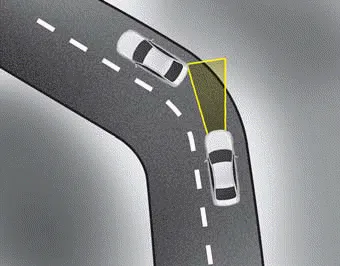
- Driving on a curve
The FCA performance may be limited while driving on a curve. The FCA may not recognize the vehicle in front even if in the same lane. It may produce the warning message and the warning alarm prematurely, or it may not produce the warning message or the warning alarm at all. When driving on a curve, exercise caution, maintain a safe braking distance, and if necessary, depress the brake pedal to reduce your driving speed in order to maintain a safe distance.
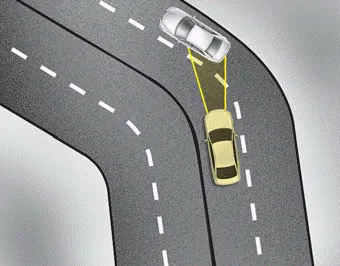
The FCA system may recognize a vehicle in an adjacent lane when driving on a curved road. In this situation, the system may apply the brake. Always pay attention to road and driving conditions while driving. If necessary, depress the brake pedal to reduce your driving speed in order to maintain a safe distance. Also, when necessary, you may depress the accelerator pedal to prevent the system from unnecessarily decelerating your vehicle. Always check the traffic conditions around the vehicle.

- Driving on a slope
The FCA performance may be limited while driving upward or downward on a slope, and may not recognize a vehicle in front in the same lane. It may produce the warning message and the warning alarm prematurely, or it may not produce the warning message and the warning alarm at all.
When the FCA suddenly recognizes the vehicle in front while passing over a slope, you may experience sharp deceleration.
Always keep your eyes forward while driving upward or downward on a slope, and, if necessary, depress the brake pedal.
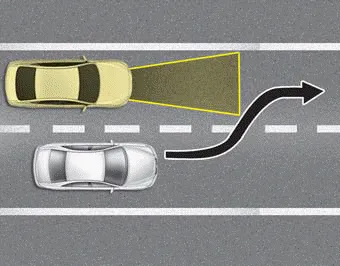
- Changing lanes
When a vehicle changes lanes in front of you, the FCA system may not immediately detect the vehicle, especially if the vehicle changes lanes abruptly. In this situation, you must maintain a safe braking distance, and if necessary, depress the brake pedal to reduce your driving speed in order to maintain a safe distance.
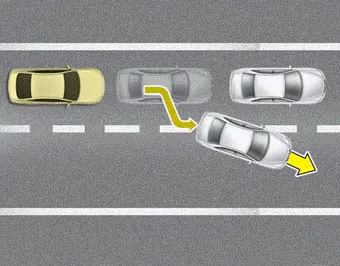
When driving in stop-and-go traffic, and a stopped vehicle in front of you merges out of the lane, the FCA system may not immediately detect the new vehicle that is now in front of you. In this situation, you must maintain a safe braking distance, and if necessary, depress the brake pedal to reduce your driving speed in order to maintain a safe distance.
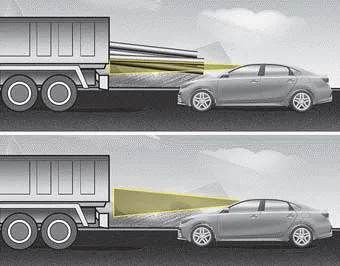
- Recognizing the vehicle
If the vehicle in front of you has cargo that extends rearward from the cab, or when the vehicle in front of you has higher ground clearance, additional special attention is required. The FCA system may not be able to recognize the cargo extending from the vehicle. In these instances, you must maintain a safe braking distance from the rearmost object, and if necessary, depress the brake pedal to reduce your driving speed in order to maintain a safe distance.
WARNING
- Do not use the FCA system when towing a vehicle. Cancel the FCA in the User Settings on the LCD display before towing. Brake application by the FCA system while towing may adversely affect your safety.
- Use extreme caution when the vehicle in front of you has cargo that extends rearward from the cab, or when the vehicle in front of you has higher ground clearance.
- The FCA system is designed to detect and monitor the vehicle ahead through camera recognition. It is not designed to detect pedestrians, bicycles, motorcycles, or smaller wheeled objects such as luggage bags, shopping carts, or strollers.
- The FCA system may not operate in certain situations. Therefore, never test the operation of the FCA system using a person or object, as doing so may cause severe injury or even death.
- When replacing or reinstalling the windscreen, or camera after removal, have the vehicle inspected by an authorized Kia dealer.
✽ NOTICE
In some instances, the FCA system may be canceled when subjected to electromagnetic interference.
When the FCA is not working properly, the FCA warning light ( ) will illuminate and the warning message will appear for a few seconds. After the message disappears, the master warning light ( ) will illuminate.
The FCA system is designed to detect and monitor the vehicle ahead or detect a pedestrian in the roadway through radar signals and camera recognition to warn the driver that a collision is imminent, and if necessary, apply emergency braking.
Other information:
Kia Forte 2019-2024 (BD) Owner's Manual: Checking the tire inflation pressure
1.After driving approximately 7~10 km (4~6 miles) or about 10 minutes, stop at a suitable location. 2.Connect the filling hose (3) of the compressor (clip mounted side) directly and then connect the filling hose (3) (opposite side) to the tire valve.
Kia Forte 2019-2024 (BD) Owner's Manual: Blade replacement
When the wipers no longer clean adequately, the blades may be worn or cracked, and require replacement. To prevent damage to the wiper arms or other components, do not attempt to move the wipers manually. Aftermarket wiper blades may result in wiper malfunction and/or failure.
Categories
- Manuals Home
- Kia Forte Owners Manual
- Changing tires
- Recommended lubricants and capacities
- Your vehicle at a glance
- New on site
- Most important about car
